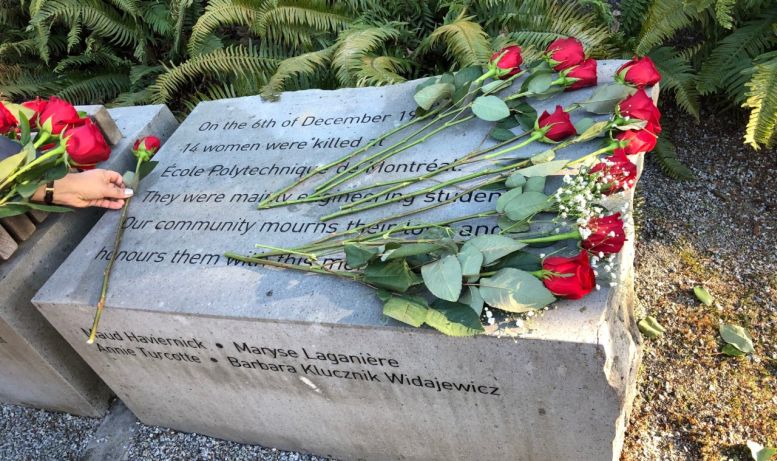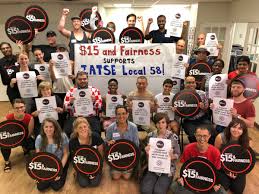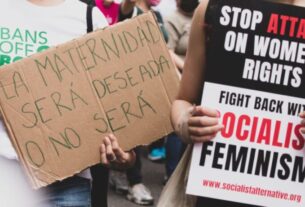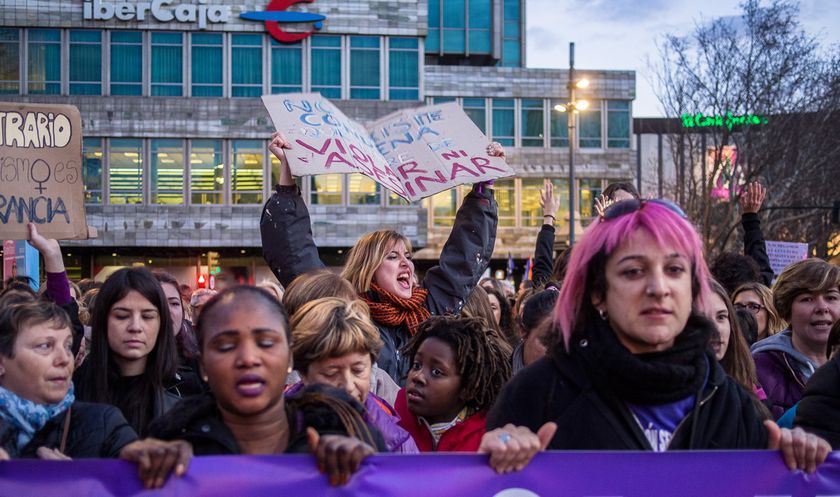Violence against women is a larger and more pervasive issue than most people think. It is an undeclared epidemic. Days ago, news broke about an alleged serial killer who preyed on Indigenous women in Manitoba. The bodies of Morgan Harris, Rebecca Contois, Marcedes Myran and Buffalo Woman (whose identity has not been determined) have been found and police believe all were murdered between March and May, 2022. This tragic news has raised questions about lack of government action on the 2019 Missing and Murdered Indigenous Women inquiry.
On December 6, as women across Canada mourn the 14 women who were murdered in 1989 at Polytechnique Montreal, the reality of misogyny and violence against women is hard to escape.
News reports of women who were raped by multiple junior hockey players and covered up by Hockey Canada are among the recent revelations. Months ago, it was reports of misogyny and sexual harassment in the Canadian Armed Forces. This summer it was revealed that several Indigenous women had gone missing. In May, the body of Chelsea Poorman, whose family had been looking for her for over a year, was found wrapped in a blanket, with several fingers missing on the grounds of an abandoned mansion — yet the police said there was nothing suspicious! In 2021, it was reports of sexual assaults on several university campuses that attracted attention.
The fact is that violence against women and LGBTQ+ folks is a worldwide phenomenon. The state violence against women has captured attention all over the world after the brutal killing of Jina (Mahsa) Amini by Iranian authorities for allegedly violating strict Islamic dress codes. Masses of protestors in Iran have taken to the streets shouting the slogan, “Woman, life, freedom.” This killing has mobilized millions around the world. In Canada, solidarity rallies in several cities have been held for weeks now. Noushin Nabavi, who wrote an article in The Tyee said that her own “Handmaid’s Tale-esque experiences with Iran’s morality police were as a teenager who got serious warnings in an all-girl school against wearing nail polish or colourful socks outside of neutral school uniform colours.” She said the Iranian regime considers women second-class citizens who aren’t entitled to the same rights and freedoms as men and that the Iranian regime uses police brutality and re-education centres to discipline girls.
Femicide
On December 6, 1989, 33 years ago, 14 young women at Polytechnique Montréal were murdered. This act of mass murder by a lone gunman, who specifically targeted women, shook Canadians to the core and laid bare the violent misogyny that lies beneath the surface of our society. Canada’s Parliament designated December 6 as The National Day of Remembrance and Action on Violence Against Women. The Canadian Femicide Observatory for Justice and Accountability says that one woman or girl is killed every other day, on average, somewhere in Canada. Further, women’s marginalization and vulnerability to femicide is increased by other forms of oppression, including racism and poverty.
Women are Vulnerable on the Streets
Safety in public places and on the street is an issue for women. The kidnap and murder of Sarah Everard in London in 2021 by an off-duty police officer and the attack and killing of Ashling Murphy in Ireland in 2022 while jogging along a canal in her hometown are some recent high-profile examples. But there are many examples of women who have been attacked by strangers, some never to be found again.
Over a period of more than two decades, between 1978 and 2001, there were dozens of unexplained disappearances of women around Vancouver’s Downtown Eastside, many of them sex workers. At least 65 women disappeared. Vancouver’s police ignored the disappearances for years and took many more years to finally catch the largest serial killer in Canadian history.
Indigenous Women among the most Vulnerable
Many of those most vulnerable to such attacks are poor and Indigenous. A Survey of Safety in Public and Private Spaces (SSPPS) was conducted in 2018. It defined violent victimization as:
Physical assault: An attack (being hit, slapped, grabbed, pushed, knocked down, or beaten), a threat of physical harm, or an incident with a weapon present; and
Sexual assault: Forced sexual activity, attempted forced sexual activity, unwanted sexual touching, grabbing, kissing or fondling, or sexual relations without being able to give consent.
This survey found more than six in ten (63 percent) Indigenous women have experienced physical or sexual assault in their lifetime. Up to 56 percent of Indigenous women have experienced physical assault, compared to 34 percent of non-Indigenous women and, 46 percent experienced sexual assault compared with 33 percent of non-Indigenous women.
Indigenous women are 12 times more likely to be murdered or missing than other women in Canada and six times more likely to be murdered than non-Indigenous women.
From 2016 to 2019, a National Inquiry into Missing and Murdered Indigenous Women and Girls was held, involving more than 2,380 family members, survivors of violence, experts and Knowledge Keepers who gathered stories and information across Canada in public hearings. The National Inquiry’s Final Report “reveals that persistent and deliberate human and Indigenous rights violations and abuses are the root cause behind Canada’s staggering rates of violence against Indigenous women, girls and 2SLGBTQQIA people. The two-volume report calls for transformative legal and social changes to resolve the crisis that has devastated Indigenous communities across the country.”
University Campuses
Women on university campuses are also targets for sexual violence. Countless examples of sexual assault and rape are reported on university campuses across Canada. Figures from Statistics Canada published in 2020 show that nearly three-quarters of university students in Canada “witnessed or experienced unwanted sexualized behaviours in a post-secondary setting in 2019 ─ either on campus, or in an off-campus situation that involved students or other people associated with the school.”
Just over a year ago, four students reported being sexually assaulted at Western University and these are still being investigated. For decades, women in Canadian universities have demanded that universities adopt policies to combat sexual harassment and change the sexist climate that exists in many universities. At Queen’s University, sexism has taken the form of signs mocking “no means no,” rugby songs with pro-rape lyrics, and other uses of violent messages and imagery. It took a group called The Radical Obnoxious Fucking Feminists at Queen’s University in the late 1980s, who painted signs all over campus, to finally see action on the part of the university administration. Unfortunately, despite decades of women’s activism, sexual harassment and violence is still a reality for many students.
Sports
The world of sports is not immune from sexual harassment and abuse. While the Hockey Canada scandal has drawn recent attention, women are vulnerable in many other sports including soccer, gymnastics and swimming. Increasing numbers of women, who were mentored by male coaches, are now coming out and talking about their experiences of sexual exploitation, sometimes from a very early age. The International Olympic Committee (IOC) warned that “sexual harassment and abuse happen in all sports and at all levels.” In 2016, they issued a statement calling for urgent action against serious and widespread sexual violence that is “facilitated by an organizational culture that ignores, denies, fails to prevent or even tacitly accepts such problems.”
Church, Police and Armed Forces
The abuse in church-run residential schools that was ongoing for decades is finally being acknowledged. But abuse is much more widespread.
Thirteen of the senior leaders of Canada’s armed forces are accused of sexual abuse. There are 19,000 claims of abuse as part of a class-action lawsuit.
The ongoing failings of Vancouver police are not an isolated example. Such failings are widespread. Abuse is widespread in the RCMP with several successful class-action lawsuits brought by both uniformed and civilian employees. Given the level of abuse of co-workers, it is no surprise that the police abuse the public,Val-d’Or being only one of the most outrageous, and nothing was done.
At Home
The lyrics of Tracy Chapman’s song, Why? asks, “Why is a woman still not safe when she’s in her home?” The reality is that women face a higher risk of abuse and death at the hands of those who know them: in many cases, their partners. Examples abound of women who live for years with partners who assault them, sometimes afraid to leave. And even when women leave abusive relationships, they are not always safe from former partners. Courts and police often do not take violence against women seriously. According to the Assaulted Women’s Hotline, on average, every six days a woman in Canada is killed by her intimate partner. In 2009, 67 women were murdered by a current or former spouse or boyfriend. Canada’s deadliest mass murder, in Nova Scotia in April 2020, started after the gunman assaulted his partner.
Misogyny and Abuse Embedded in the System
Across many institutions, there is deep misogyny as exemplified by the armed forces, police, churches, sports and universities. Many of these organizations are very top-down. Much abuse and violence is based on power and domination. Many institutions are based on or reinforce authority and power so at best they turn a blind eye to abuse and at worst, they create a culture that favours abusers.
While women and 2SLGBTQQIA people are most frequently abused, abusers also target boys and men as shown by church schools such as Mount Cashel and Vancouver College and sports coaches. In the claim against Canada’s armed forces, 57 per cent of the claimants are female, 42 per cent are male, and one per cent identify as other.
There have been countless reports and studies, filled with recommendations, but little changes. Putting women, such as RCMP Commissioner Brenda Lucki, in leadership roles makes little difference. This is because abuse is rooted in the system and its institutions.
The System is Capitalism
At the root of this misogyny is the capitalism system that relies on divide and rule to reinforce the power of the ruling class and the state. Sexual harassment, abuse and violence is about power and control. It is about maintaining the power imbalance between men and women. The division of labour between men and women benefits capitalism: the ruling class has a vested interest in maintaining this inequality. Gender inequality is not part of human nature and has not always been part of human existence. Rather, it is rooted in early societies that accumulated surplus wealth and property to pass onto future generations, through creating a male lineage. While this system precedes capitalism, capitalism’s focus on profits at all cost has reinforced the power of men over women and other genders.
Violence and rape are consciously used by the ruling class and the state, particularly in response to fears of revolution. Chile and Sudan are recent examples but there are many more. In times of war, women are particularly vulnerable to sexual violence, which weaponizes rape as a tool of war.
International Solidarity and Struggle
In commemoration of the United Nations’ International Day for the Elimination of Violence against Women on November 25, International Socialist Alternative, issued a statement. This statement notes that the “revolutionary movement in Iran shows … how deeply misogyny, violence and sexism are interlinked with state violence, repression and the entire capitalist system.” While we point out that the system itself is guilty in every aspect, we have to fight for a completely different society. Gender-based violence is an expression of a deeply violent system.
What will make a difference is mobilizing and organizing for a socialist-feminist movement in our workplaces, schools, universities and communities. In addition to demanding an end to every form of gender-based violence, we need to fight for mass investments in health care, education, public affordable housing, services, and liveable wages. Finally, we need to eliminate the root of women’s oppression and fight for a socialist alternative to capitalist barbarism.
As the poet Marge Piercy says: “Strong is what we make each other. Until we are all strong together, a strong woman is a woman strongly afraid.”




